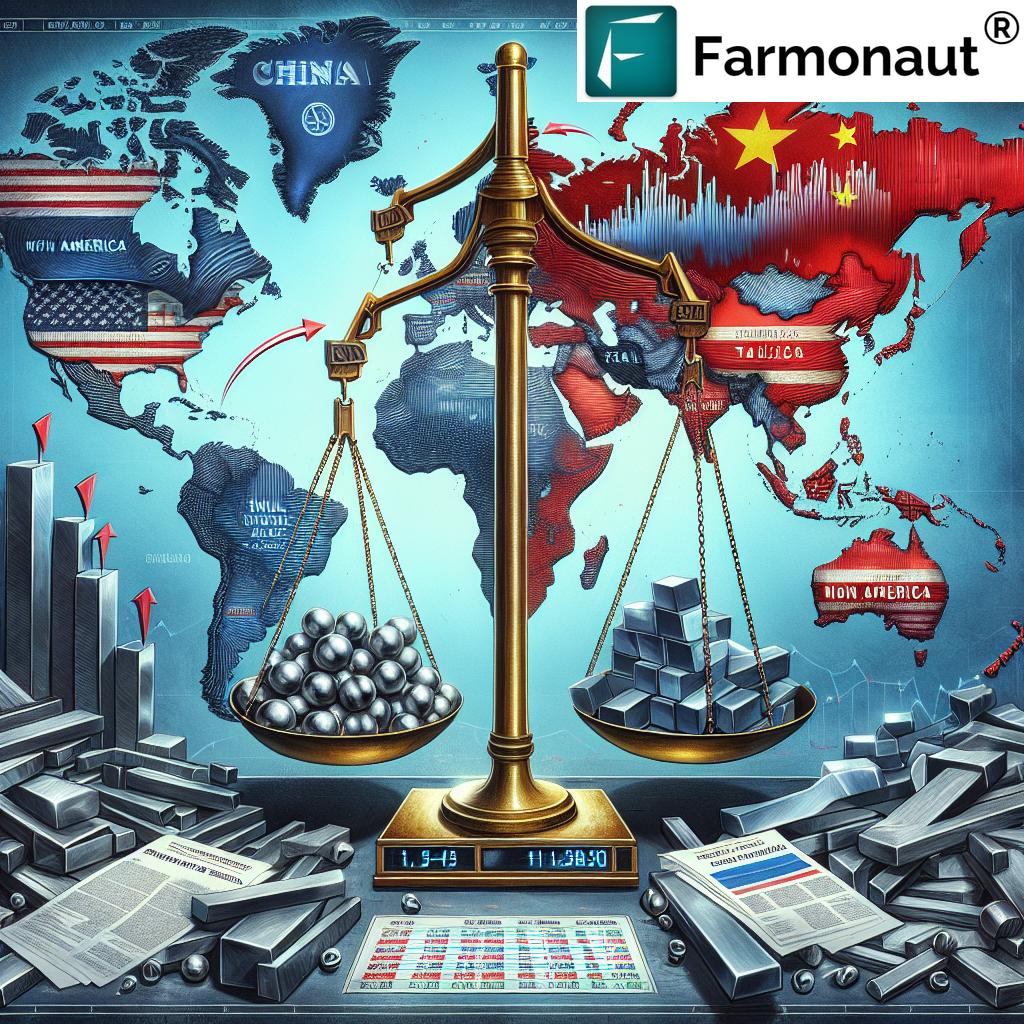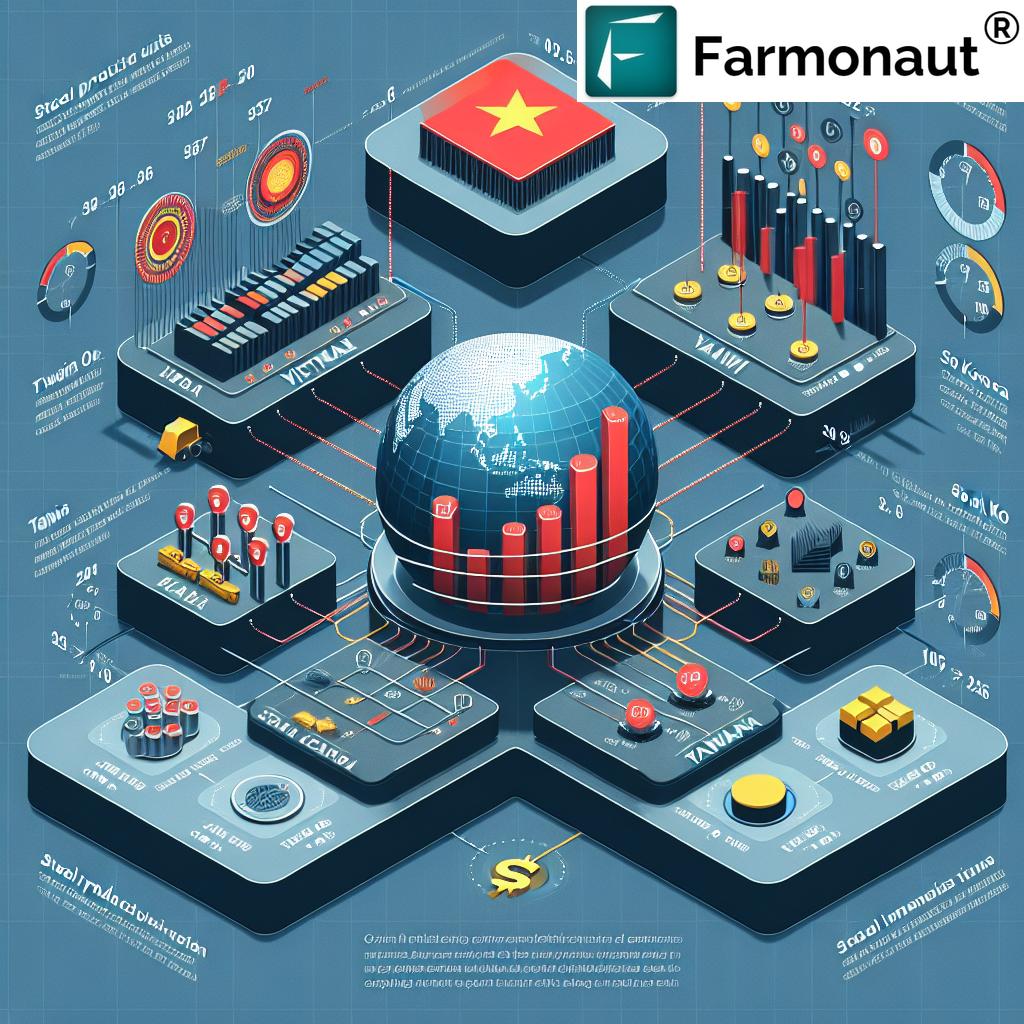Global Steel Tariffs Escalate: Impact on APAC Economies and Trade War Tensions

“The US reintroduced a 25% tariff on imported aluminum and steel, impacting stock prices of European and Asian producers.”
In the ever-evolving landscape of global trade, recent developments have sent shockwaves through international markets, particularly affecting the Asia-Pacific (APAC) region. The reintroduction of US steel tariffs has reignited trade war tensions, creating a ripple effect that threatens to reshape economic relationships and growth projections across the globe. As we delve into this complex issue, we’ll explore the far-reaching implications of these trade disputes on global markets, international relations, and future economic forecasts.
The Resurgence of US Steel Tariffs
On February 11, reports highlighted the ongoing implications of U.S. President Donald Trump’s trade policies, particularly concerning tariffs on aluminum and steel imports. The Trump administration has reintroduced a 25% tariff on all imported aluminum and steel, escalating trade war tensions that threaten the economies of various Asian countries. This move adds to the already established tariffs of 25% on steel and 10% on aluminum imposed during his initial term.
Previously, exemptions were granted to several pivotal trading partners such as Canada and Mexico. Under President Joe Biden’s administration, there was a further expansion of tariff-free quotas extended to the UK, Japan, and the EU. However, the recent policy shift has effectively nullified these exemptions, creating a blanket tariff that affects all steel and aluminum imports.
Immediate Market Reactions
- Stock prices of European and Asian steel producers plummeted
- Retaliatory rhetoric emerged from European leaders
- China initiated its own counter-strategy with new tariffs on certain U.S. goods
The immediate effect of Trump’s announcement was observed in the stock market. European and Asian steel producers saw their stock prices tumble, prompting swift reactions from global leaders. French President Emmanuel Macron warned that U.S. tariffs would heighten inflation for American citizens, expressing readiness to confront the U.S. in a trade battle. German Chancellor Olaf Scholz also affirmed that the EU could respond swiftly to any increases in U.S. tariffs.
Simultaneously, China initiated its own counter-strategy by enforcing new tariffs on certain U.S. goods. This action followed Trump’s earlier 10% tariff increase on a range of Chinese products. The recent Chinese tariffs targeted an estimated $13.86 billion worth of U.S. goods, including coal, liquefied natural gas, and agricultural machinery. The situation is worrisome for global observers as both the U.S. and China appear entrenched in a retaliatory cycle.
The Ripple Effect on APAC Economies
While China exports significant volumes of steel and aluminum, it’s not a primary exporter to the U.S. However, China leverages its surplus by shipping these metals to third-party countries. This tactic holds implications for other Asian markets like South Korea, Vietnam, and Taiwan, which are also significant steel exporters to the U.S. These economies face direct fallout from the U.S. tax policy.
The already beleaguered Chinese real estate sector compounds these trade tensions, resulting in an oversupply of steel and aluminum. This pushes China to increase exports to markets, including Southeast Asia, thereby indirectly influencing the trade landscapes of neighboring countries.
In response to these developments, assessments indicate significant challenges ahead for the Asia-Pacific (APAC) region. Sagarika Chandra, Director of National Credit Ratings at Fitch Ratings, labeled the increased protectionism as an obstacle to economic growth for many APAC economies. Countries like Vietnam, Taiwan, Thailand, and South Korea may feel particularly vulnerable as they heavily rely on exports to the U.S.
Earn With Farmonaut: Join our affiliate program and earn 20% recurring commission by sharing your promo code and helping farmers save 10%. Onboard 10 Elite farmers monthly to earn a minimum of $148,000 annually—start now and grow your income!
Economic Impact Comparison of Steel Tariffs on APAC Economies
| Country | Estimated GDP Growth Impact (%) | Steel Export Value to US ($ billions) | Projected Job Losses | Retaliatory Measures |
|---|---|---|---|---|
| China | -0.5 | 1.2 | 50,000 | Tariffs on $13.86 billion US goods |
| South Korea | -0.3 | 3.5 | 20,000 | WTO complaint filed |
| Japan | -0.2 | 1.8 | 15,000 | Considering EU alliance |
| Vietnam | -0.4 | 0.9 | 10,000 | Diversifying export markets |
| Taiwan | -0.3 | 1.3 | 12,000 | Exploring new trade partnerships |
“Despite trade tensions, APAC economies are projected to outpace other regions in economic growth by 2025.”
APAC Economic Growth Forecast
Despite projecting a slowdown in growth for more than half of the APAC economies by 2025, there remain optimistic outlooks for Australia, New Zealand, and Japan, which are expected to recover from prior weaknesses. Overall, however, the APAC region is predicted to maintain a higher growth rate relative to other regions despite these challenges, with the U.S. acting as a key export market.
The compounding effects of tariffs not only signify heightened economic tensions but also underscore the interconnectedness of global trade and the fragility of international economic stability amidst escalating confrontations.
Explore Farmonaut’s Satellite API
Global Steel Industry: Challenges and Adaptations
The global steel industry finds itself at a crossroads, facing unprecedented challenges due to the escalating trade war and tariff impositions. Steel producers worldwide are grappling with market uncertainties, fluctuating demand, and the need to adapt to a rapidly changing trade landscape.
- Overcapacity issues persist, particularly in China
- European steel producers seek government protection
- Emerging markets explore new export destinations
- Innovation in steel production becomes crucial for competitiveness
As the industry navigates these turbulent waters, the focus shifts towards technological advancements and sustainable practices. Steel companies are investing in research and development to create more efficient, environmentally friendly production methods. This push for innovation could potentially reshape the global steel market in the coming years.
US Trade Policy Effects: A Double-Edged Sword
The US trade policy, particularly concerning steel tariffs, presents a complex scenario with both domestic and international implications. While aimed at protecting American steel producers, these policies have far-reaching consequences that extend beyond the intended benefits.
Domestic Impact:
- Potential boost for US steel producers
- Increased costs for industries relying on steel imports
- Possible job creation in the steel sector, but job losses in steel-consuming industries
- Risk of inflation and higher consumer prices
International Repercussions:
- Strained diplomatic relations with key allies
- Potential for retaliatory measures from affected countries
- Disruption of global supply chains
- Increased uncertainty in international trade
The effectiveness of these trade policies in achieving their intended goals remains a subject of debate among economists and policymakers. As the situation evolves, careful monitoring of both short-term effects and long-term trends will be crucial for understanding the full impact of these measures.
Access Farmonaut’s API Developer Docs
International Trade Disputes: A Global Perspective
The current steel tariff situation is just one facet of a broader landscape of international trade disputes. These conflicts reflect deeper issues within the global economic system and highlight the challenges of balancing national interests with international cooperation.

Key aspects of these global trade tensions include:
- Increasing protectionist measures across various sectors
- Challenges to the authority and effectiveness of international trade organizations
- The rise of bilateral trade agreements as alternatives to multilateral frameworks
- Growing concerns over intellectual property rights and technology transfer
These disputes are not merely economic in nature but often intertwine with geopolitical considerations, making resolution complex and multifaceted. The ongoing tensions between major economic powers like the US and China have ripple effects that impact global markets, supply chains, and diplomatic relations.
Tariff Retaliation Measures: A Cycle of Economic Confrontation
As countries respond to the US steel tariffs with their own retaliatory measures, we’re witnessing a cycle of economic confrontation that threatens to escalate further. This tit-for-tat approach to trade policy has several implications:
- Increased costs for businesses and consumers across multiple sectors
- Disruption of established trade flows and supply chains
- Potential for broader economic slowdown if tensions continue to escalate
- Challenges for diplomacy and international cooperation
The EU, China, and other affected countries have implemented or are considering a range of retaliatory measures, including:
- Targeted tariffs on US goods
- Complaints filed with the World Trade Organization (WTO)
- Exploration of new trade partnerships to reduce dependency on US markets
- Domestic support measures for affected industries
These retaliatory actions, while intended to protect domestic interests, risk creating a negative feedback loop that could have long-lasting impacts on global trade and economic growth.
Steel Export Challenges: Navigating Uncertain Waters
For steel exporters, particularly those in the APAC region, the current trade environment presents significant challenges. These exporters must navigate a complex landscape of tariffs, changing demand patterns, and increased competition. Key challenges include:
- Reduced competitiveness in the US market due to tariffs
- Need to find alternative export destinations
- Pressure to innovate and reduce production costs
- Managing overcapacity issues, especially in China
- Adapting to changing global supply chains
To address these challenges, steel exporters are exploring various strategies:
- Diversifying export markets to reduce dependence on any single destination
- Investing in value-added products to maintain competitiveness
- Forming strategic partnerships with downstream industries
- Advocating for supportive government policies in their home countries
The ability of steel exporters to adapt to these new realities will be crucial in determining the future shape of the global steel industry.
The Role of Technology in Mitigating Trade Tensions
In these challenging times, technology plays a crucial role in helping businesses navigate the complexities of international trade. Advanced tools and platforms can provide valuable insights and solutions to mitigate the impact of trade tensions. For instance, Farmonaut, while primarily focused on agricultural technology, demonstrates how innovative tech solutions can support industries in adapting to changing global landscapes.
Key technological advancements aiding industries include:
- AI-driven market analysis and forecasting
- Blockchain for supply chain transparency and traceability
- Big data analytics for optimizing operations and logistics
- Digital platforms for facilitating international trade and compliance
These technologies enable businesses to make more informed decisions, adapt quickly to policy changes, and find new opportunities in a shifting global market.
Looking Ahead: Future Prospects for APAC Economies
Despite the current challenges posed by trade tensions and tariffs, the long-term outlook for APAC economies remains cautiously optimistic. The region’s resilience, adaptability, and continued focus on innovation position it well for future growth. Key factors influencing the future prospects include:
- Ongoing economic reforms and liberalization in many APAC countries
- Increasing intra-regional trade and economic integration
- Growing middle class and domestic consumption in emerging markets
- Investments in infrastructure and digital technologies
- Emphasis on sustainable development and green technologies
While the impact of US steel tariffs and ongoing trade tensions present significant hurdles, they also create opportunities for APAC economies to diversify, innovate, and strengthen regional economic ties. The ability of these economies to navigate the current challenges while laying the groundwork for future growth will be crucial in shaping the region’s economic landscape in the coming years.
Conclusion: Navigating the Complex Web of Global Trade
The escalation of global steel tariffs and its impact on APAC economies underscores the intricate and interconnected nature of international trade. As we’ve explored, the repercussions of these trade policies extend far beyond the steel industry, affecting various sectors, diplomatic relations, and economic growth projections.
Key takeaways from our analysis include:
- The immediate and long-term effects of US steel tariffs on global markets
- The varied responses and retaliatory measures from affected countries
- The challenges and opportunities facing APAC economies in this new trade landscape
- The importance of innovation and adaptability in navigating trade tensions
- The potential for technology to mitigate some of the negative impacts of trade disputes
As the situation continues to evolve, it’s clear that a balanced approach considering both national interests and international cooperation will be crucial. The resilience and adaptability of global markets, particularly in the APAC region, will be tested as they navigate these uncertain waters.
For businesses and policymakers alike, staying informed, flexible, and innovative will be key to thriving in this complex global trade environment. As we move forward, the lessons learned from these trade tensions will likely shape international economic policies and relationships for years to come.
FAQ Section
Q: How do the US steel tariffs affect global steel prices?
A: US steel tariffs tend to increase domestic steel prices in the US, which can lead to higher costs for steel-consuming industries. Globally, it may cause oversupply in other markets as steel producers seek alternative destinations for their exports, potentially lowering prices in those regions.
Q: What are the main reasons behind the US imposing steel tariffs?
A: The primary reasons include protecting domestic steel producers, addressing global overcapacity issues (particularly from China), and using tariffs as leverage in broader trade negotiations.
Q: How are APAC countries responding to these trade tensions?
A: APAC countries are responding through various means, including filing WTO complaints, imposing retaliatory tariffs, seeking new trade partnerships, and investing in domestic industries to reduce reliance on imports.
Q: What long-term effects might these trade tensions have on global supply chains?
A: Long-term effects could include the restructuring of global supply chains, increased regionalization of trade, and a shift towards more diversified sourcing strategies to mitigate risks associated with trade disputes.
Q: How might these trade tensions impact consumers?
A: Consumers may face higher prices for goods that use steel and aluminum, as increased costs are often passed down the supply chain. This could affect products ranging from automobiles to household appliances.






